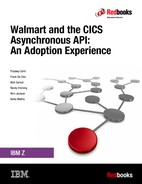Book Description
Abstract
This IBM® Redbooks® publication discusses practical uses of the IBM CICS asynchronous API capability. It describes the methodology, design and thought process used by a large client, Walmart, and the considerations of the choices made. The Redbooks publication provides real life examples and application patterns that benefit from the performance and scalability offered by the new API.
The book discusses the homegrown methodology used by Walmart before the API was available and compares it with the design using the new API. A discussion of the process used to migrate older applications to begin using the new API is included so the reader will understand the ease of implementing the new API. A description of real world usage patterns describes the current production application Walmart has deployed as well as other patterns to give the reader a sense of what's possible applying creative thinking with technology improvements. Finally, a section is included on the areas to be considered as you begin to plan and implement asynchronous API capabilities.
This book should be read by:
Enterprise Architects searching for faster ways to service strategic applications across the enterprise.
Solution Architects who want to better understand implementation possibilities for improved response times and better performance for CICS applications.
CICS programmers looking to modernize and provide improved response times.
